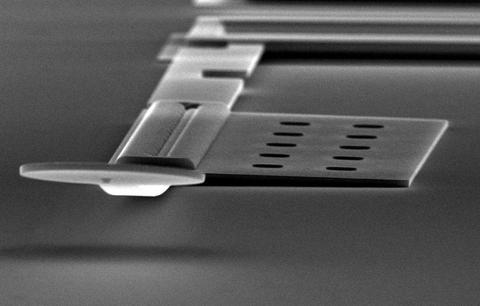
Closeup view of the robot built by engineering students at the U.S. Naval Academy for the NIST-coordinated nanosoccer competition at the 2007 RoboCup in Atlanta. The Midshipmen will be fielding their miniature soccer player (about 300 micrometers in length—the size of a dust mite) against four challengers at the upcoming RoboCup in Austria.
The National Institute of Standards and Technology (NIST) will be serving up "soccer under glass" - the glass of a microscope lens - when nanosoccer makes its second appearance at the RoboCup games at the international competition in Graz, Austria, from June 29 to July 5, 2009.
Nanosoccer is a Lilliputian event where computer-driven "nanobots" the size of dust mites challenge one another on fields no bigger than a grain of rice. Viewed under a microscope, the nanobots are operated by remote control and move in response to changing magnetic fields or electrical signals transmitted across the microsized arena. "Nanoscale" refers to their mass. The bots are a few tens of micrometers to a few hundred micrometers long, but their masses can be just a few nanograms. They are manufactured from materials such as aluminum, nickel, gold, silicon and chromium.
The Nanogram 2009 demonstration will consist of two qualifier events and one competition event: the two-millimeter dash in which nanobots seek fast times for a goal-to-goal sprint across the playing field; a slalom course where the path between goals is blocked by "defenders" (polymer posts); and a ball handling "shootout" exercise that requires robots to move "nanoballs" (spheres about the diameter of a human hair) into the goal. Unlike the initial Nanogram demonstration at the 2007 RoboCup in Atlanta, performance in the qualifier events will determine which robots compete in the shootout.
The teams competing in Graz will include ETH Zurich (Zurich, Switzerland), Johns Hopkins University (Baltimore, Md.), the U.S. Naval Academy (Annapolis, Md.), the University of Waterloo (Waterloo, Ontario, Canada) and the Universite' de Sherbrooke (Quebec, Canada).
Nanosoccer contests "road test" agility, maneuverability, response to computer control and the ability to move objects—all skills that future industrial nanobots will need for tasks such as microsurgery within the human body or the manufacture of tiny components for microscopic electronic devices.
NIST organizes the Nanogram 2009 events with the RoboCup Federation, an international organization dedicated to fostering innovations and advances in artificial intelligence and intelligent robotics by using the game of soccer as a testing ground. NIST's goal in coordinating nanosoccer competitions between the world's smallest robots is to show the feasibility and accessibility of technologies for fabricating MicroElectroMechanical Systems (MEMS), tiny mechanical devices built onto semiconductor chips and measured in micrometers (millionth of a meter). The contests also drive innovation in this new field of robotics by inspiring young scientists and engineers to become involved.
For more information, go to the "NIST and Nanosoccer" Web site.

